Subunit-specific contribution of pore-forming domains to NMDA receptor channel structure and gating
- PMID: 17504910
- PMCID: PMC2151626
- DOI: 10.1085/jgp.200609718
Subunit-specific contribution of pore-forming domains to NMDA receptor channel structure and gating
Abstract
N-methyl-D-aspartate receptors (NMDARs) are ligand-gated ion channels that contribute to fundamental physiological processes such as learning and memory and, when dysfunctional, to pathophysiological conditions such as neurodegenerative diseases, stroke, and mental illness. NMDARs are obligate heteromultimers typically composed of NR1 and NR2 subunits with the different subunits underlying the functional versatility of NMDARs. To study the contribution of the different subunits to NMDAR channel structure and gating, we compared the effects of cysteine-reactive agents on cysteines substituted in and around the M1, M3, and M4 segments of the NR1 and NR2C subunits. Based on the voltage dependence of cysteine modification, we find that, both in NR1 and NR2C, M3 appears to be the only transmembrane segment that contributes to the deep (or voltage dependent) portion of the ion channel pore. This contribution, however, is subunit specific with more positions in NR1 than in NR2C facing the central pore. Complimentarily, NR2C makes a greater contribution than NR1 to the shallow (or voltage independent) portion of the pore with more NR2C positions in pre-M1 and M3-S2 linker lining the ion-conducting pathway. Substituted cysteines in the M3 segments in NR1 and NR2C showed strong, albeit different, state-dependent reactivity, suggesting that they play central but structurally distinct roles in gating. A weaker state dependence was observed for the pre-M1 regions in both subunits. Compared to M1 and M3, the M4 segments in both NR1 and NR2C subunits had limited accessibility and the weakest state dependence, suggesting that they are peripheral to the central pore. Finally, we propose that Lurcher mutation-like effects, which were identified in and around all three transmembrane segments, occur for positions located at dynamic protein-protein or protein-lipid interfaces that have state-dependent accessibility to methanethiosulfonate (MTS) reagents and therefore can affect the equilibrium between open and closed states following reactions with MTS reagents.
Figures

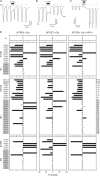


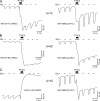
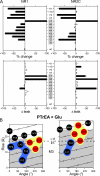

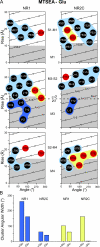
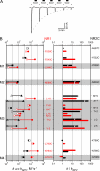
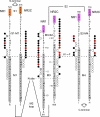
Similar articles
-
Staggering of subunits in NMDAR channels.Biophys J. 2002 Dec;83(6):3304-14. doi: 10.1016/S0006-3495(02)75331-9. Biophys J. 2002. PMID: 12496098 Free PMC article.
-
NR3A modulates the outer vestibule of the "NMDA" receptor channel.J Neurosci. 2006 Dec 20;26(51):13156-66. doi: 10.1523/JNEUROSCI.2552-06.2006. J Neurosci. 2006. PMID: 17182766 Free PMC article.
-
Arrangement of subunits in functional NMDA receptors.J Neurosci. 2011 Aug 3;31(31):11295-304. doi: 10.1523/JNEUROSCI.5612-10.2011. J Neurosci. 2011. PMID: 21813689 Free PMC article.
-
N-[2-(N-(2-mercaptoethyl)) amino ethyl]-N-(2-mercaptoethyl)-3,5-dimethylacetamide amantadine-technetium.2012 Jun 12 [updated 2012 Jul 17]. In: Molecular Imaging and Contrast Agent Database (MICAD) [Internet]. Bethesda (MD): National Center for Biotechnology Information (US); 2004–2013. 2012 Jun 12 [updated 2012 Jul 17]. In: Molecular Imaging and Contrast Agent Database (MICAD) [Internet]. Bethesda (MD): National Center for Biotechnology Information (US); 2004–2013. PMID: 22812023 Free Books & Documents. Review.
-
Assembly of N-methyl-D-aspartate (NMDA) receptors.Biochem Soc Trans. 2003 Aug;31(Pt 4):865-8. doi: 10.1042/bst0310865. Biochem Soc Trans. 2003. PMID: 12887323 Review.
Cited by
-
Cadmium activates AMPA and NMDA receptors with M3 helix cysteine substitutions.J Gen Physiol. 2020 Jul 6;152(7):e201912537. doi: 10.1085/jgp.201912537. J Gen Physiol. 2020. PMID: 32342094 Free PMC article.
-
The LILI Motif of M3-S2 Linkers Is a Component of the NMDA Receptor Channel Gate.Front Mol Neurosci. 2018 Apr 6;11:113. doi: 10.3389/fnmol.2018.00113. eCollection 2018. Front Mol Neurosci. 2018. PMID: 29681798 Free PMC article.
-
Advancing NMDA Receptor Physiology by Integrating Multiple Approaches.Trends Neurosci. 2017 Mar;40(3):129-137. doi: 10.1016/j.tins.2017.01.001. Epub 2017 Feb 8. Trends Neurosci. 2017. PMID: 28187950 Free PMC article. Review.
-
A novel alcohol-sensitive position in the N-methyl-D-aspartate receptor GluN2A subunit M3 domain regulates agonist affinity and ion channel gating.Mol Pharmacol. 2013 Oct;84(4):501-10. doi: 10.1124/mol.113.085993. Epub 2013 Jul 11. Mol Pharmacol. 2013. PMID: 23847085 Free PMC article.
-
Glutamate receptor pores.J Physiol. 2015 Jan 1;593(1):49-59. doi: 10.1113/jphysiol.2014.272724. Epub 2014 May 6. J Physiol. 2015. PMID: 25556787 Free PMC article. Review.
References
-
- Banke, T.G., and S.F. Traynelis. 2003. Activation of NR1/NR2B NMDA receptors. Nat. Neurosci. 6:144–152. - PubMed
-
- Beck, C., L.P. Wollmuth, P.H. Seeburg, B. Sakmann, and T. Kuner. 1999. NMDAR channel segments forming the extracellular vestibule inferred from the accessibility of substituted cysteines. Neuron. 22:559–570. - PubMed
-
- Chatterton, J.E., M. Awobuluyi, L.S. Premkumar, H. Takahashi, M. Talantova, Y. Shin, J. Cui, S. Tu, K.A. Sevarino, N. Nakanishi, et al. 2002. Excitatory glycine receptors containing the NR3 family of NMDA receptor subunits. Nature. 415:793–798. - PubMed

